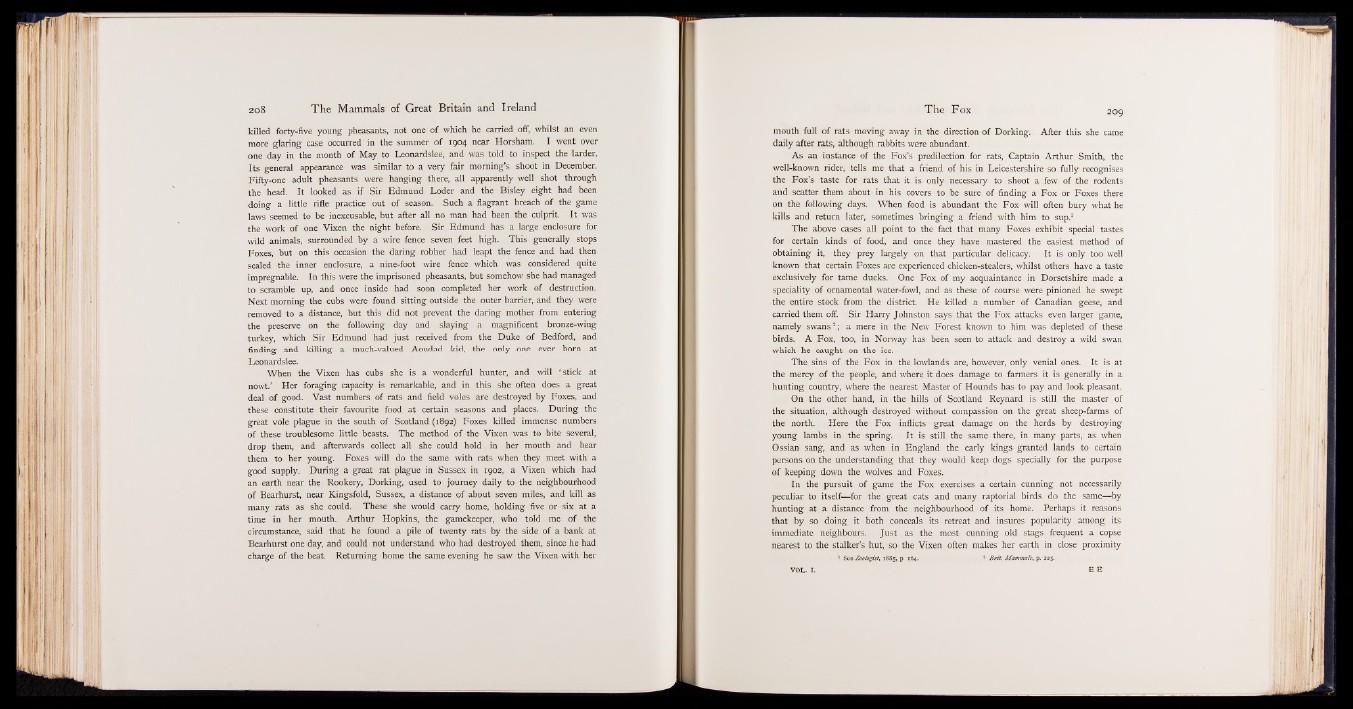
killed forty-five young pheasants, not one of which he carried off, whilst an even
more glaring case occurred in the summer of 1904 near Horsham. I went over
one day in the month of May to Leonardslee, and was told to inspect the larder.
Its general appearance was similar to a very fair morning’s shoot in December.
Fifty-one adult pheasants were hanging there, all apparently well shot through
the head. It looked as if Sir Edmund Loder and the Bisley eight had been
doing a little rifle practice out of season. Such a flagrant breach of the game
laws seemed to be inexcusable, but after all no man had been the culprit. It was
the work of one Vixen the night before. Sir Edmund has a large enclosure for
wild animals, surrounded by a wire fence seven feet high. This generally stops
Foxes, but on this occasion the daring robber had leapt the fence and had then
scaled the inner enclosure, a nine-foot wire fence which was considered quite
impregnable. In this were the imprisoned pheasants, but somehow she had managed
to scramble up, and once inside had soon completed her work of destruction.
Next morning the cubs were found sitting outside the outer barrier, and they were
removed to a distance, but this did not prevent the daring mother from entering
the preserve on the following day and slaying a magnificent bronze-wing
turkey, which Sir Edmund had just received from the Duke of Bedford, and
finding and killing a much-valued Aoudad kid, the only one ever born at
Leonardslee.
When the Vixen has cubs she is a wonderful hunter, and will ‘ stick at
nowt.’ Her foraging capacity is remarkable, and in this she often does a great
deal of good. Vast numbers of rats and field voles are destroyed by Foxes, and
these constitute their favourite food at certain seasons and places. During the
great vole plague in the south of Scotland (1892) Foxes killed immense numbers
of these troublesome little beasts. The method of the Vixen was to bite several,
drop them, and afterwards collect all she could hold in her mouth and bear
them to her young. Foxes will do the same with rats when they meet with a
good supply. During a great rat plague in Sussex in 1902, a Vixen which had
an earth near the Rookery, Dorking, used to journey daily to the neighbourhood
of Bearhurst, near Kingsfold, Sussex, a distance of about seven miles, and kill as
many rats as she could. These she would carry home, holding five or six at a
time in her mouth. Arthur Hopkins, the gamekeeper, who told me of the
circumstance, said that he found a pile of twenty rats by the side of a bank at
Bearhurst one day, and could not understand who had destroyed them, since he had
charge of the beat. Returning home the same evening he saw the Vixen with her
mouth full of rats moving away in the direction of Dorking. After this she came
daily after rats, although rabbits were abundant.
As an instance of the Fox’s predilection for rats, Captain Arthur Smith, the
well-known rider, tells me that a friend of his in Leicestershire so fully recognises
the Fox’s taste for rats that it is only necessary to shoot a few of the rodents
and scatter them about in his covers to be sure of finding a Fox or Foxes there
on the following days. When food is abundant the. Fox will often bury what he
kills and return later, sometimes bringing a friend with him to sup.1
The above cases all point to the fact that many Foxes exhibit special tastes
for certain kinds of food, and once they have mastered the easiest method of
obtaining it, they prey largely on that particular delicacy. It is only too well
known that certain Foxes are experienced chicken-stealers, whilst others have a taste
exclusively for tame ducks. One Fox of my acquaintance in Dorsetshire made a
speciality of ornamental water-fowl, and as these of course were pinioned he swept
the entire stock from the district. He killed a number of Canadian geese, and
carried them off. Sir Harry Johnston says that the Fox attacks even larger game,
namely swans2; a mere in the New Forest known to him was depleted of these
birds. A Fox, too, in Norway has been seen to attack and destroy a wild swan
which he caught on the ice,
The sins of the Fox in the lowlands are, however, only venial ones. It is at
the mercy of the people, and where it does damage to farmers it is generally in a
hunting country, where the nearest Master of Hounds has to pay and look pleasant.
On the other hand, in the hills of Scotland Reynard is still the master of
the situation, although destroyed without compassion on the great sheep-farms of
the north. Here the Fox inflicts great damage on the herds by destroying
young lambs in the spring. It is still the same there, in many parts, as when
Ossian sang, and as when in England the early kings granted lands to certain
persons on the understanding that they would keep dogs specially for the purpose
of keeping down the wolves and Foxes.
In the pursuit of game the Fox exercises a certain cunning not necessarily
peculiar to itself—for the great cats and many raptorial birds do the same— by
hunting at a distance from the neighbourhood of its home. Perhaps it reasons
that by so doing it both conceals its retreat and insures popularity among its
immediate neighbours. Just as the most cunning old stags frequent a copse
nearest to the stalker’s hut, so the Vixen often makes her earth in close proximity
• 1 See Zoologist, 1885, p 164. 2 B rit. Mammals, p. 123.